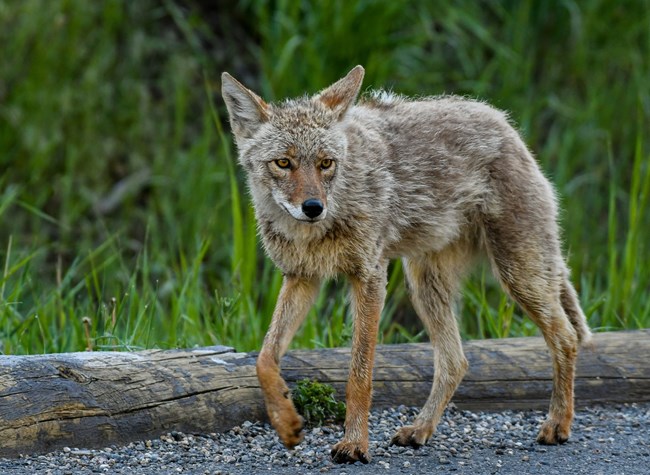Last updated: August 20, 2021
Article
Saugus Mammal Predators

NPS Photo / Jane Gamble
What mammal predators are in the park?
Coyote (Canis latrans). This member of the dog family usually hunts at night for small mammals, birds, frogs, and snakes. It has adapted to the suburban environment and occasionally preys on domestic pets like cats and small dogs as well as raiding trash cans. It will occasionally be seen in the park in the daytime. Coyote do not migrate and can be seen in the park throughout the year. Do not approach coyote if you see one and leave the area immediately if you encounter one while walking your dog.Red Fox (Vulpes vulpes). Fox are omnivores that hunt and scavenge mainly at night for rodents, rabbits, birds, insects, berries, and fruits. They are year-round residents. Fox are extremely shy so it is highly unlikely that you will see one up close.
Grey Fox (Urocyon cinereoargenteus). Grey Fox are solitary omnivores that are most active at twilight and after dark feeding primary on fruits, berries, rabbits, shrews, mice and voles. They have sharp, semi retractable claws which allow them to climb trees. They have a wide range which extents all the way from southern Canada to northern South America. They are year-round residents.
Common Raccoon (Procyon lotor). The raccoon is an omnivore that hunts and scavenges mainly at night, but occasionally in the daytime. About 1/3 of its diet is plant material like nuts and berries with the other 2/3 consisting of invertebrates and vertebrates. Raccoons especially like crayfish, fish, amphibians, and bird eggs. They are excellent climbers and a major threat to bird nests. In suburban environments like Saugus they also raid trash cans. They winter over locally in nests and dens.
Racoons are common in the park, but it is rare to see one in the daytime. Raccoons can be aggressive if they feel threatened and do occasionally carry diseases and parasites that are harmful to humans, so it is best to avoid them.
Mink (Mustela vison). This member of the weasel family is most active from dusk to dawn. Mink are excellent swimmers and feeds on fish, birds, rodents, and frogs. They are year-round residents and are active in all seasons. One of the tell-tale signs of mink are the holes they make in the snow hunting voles. They are shy and will run from one hiding place to the next.
Striped Skunk (Mephitis mephitis). This member of the weasel family is an omnivore that is active at night feeding on insects, rodents, bird and turtle eggs, fruit, roadkill, and garbage. Skunks hibernate in dens in the winter.
If threatened they can spray a stinging, foul-smelling, sulfurous liquid up to 15’ with no warning.
Northern River Otter (Lutra canadensis). The otter is a large member of the weasel family. They are active both day and night and are equally at home in the water or on land. They eat fish, crayfish, carrion, snakes, and any small animal they can catch. They can run and swim very fast, so it is unlikely you will get close to one.
They are common in the region (including the park) but rarely seen. They have large territories and move around depending on food availability and how they feel that day. As with all wildlife, the best thing to do is to view them from a distance. Otters are fairly large and will bite if they feel threatened. They are often tolerant of being watched from a distance. Otters can be incredibly entertaining to watch. They regularly play together, are acrobatic in the water and on land, and most people find them cute.
Domestic Cat (Felis catus). Cats are fearsome predators that regularly capture and kill many small mammals, like mice, voles, gray squirrels, flying squirrels, and moles, as well as snakes and birds. This is true of both house pets and feral cats. Pet cats should not be allowed outside off-leash both to limit their predation and to protect them from cars and coyotes.
